| (fullsize FM keyboard with nice sound, FM accompaniment & drumpads) |
This strange fullsize instrument may have been the first FM song bank keyboard of the "MC" series (genuinely made by Medeli?), because it contains fairly complex multi- chip hardware and has various small oddities in its behaviour. E.g. unlike other song bank instruments it has instead of 100 only 87 preset sounds (when you enter higher 2 digit numbers, it repeats the sounds {00..11} on {88..99}), and although its 8 drumpad buttons play lo-fi sample percussion, the 10 OBS preset rhythms employ only classic standard FM percussion (which sounds very electronic). Apparently the drumpad IC was simply added later to a finished FM keyboard hardware design and thus does not communicate with the rest in any way. Unfortunately an annoying keyboard polyphony flaw sometimes truncates held notes.
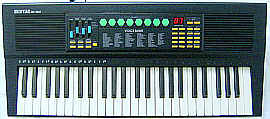 |
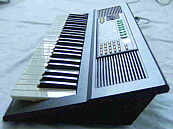 |
This instrument was also released as Trend Line MC 3800.
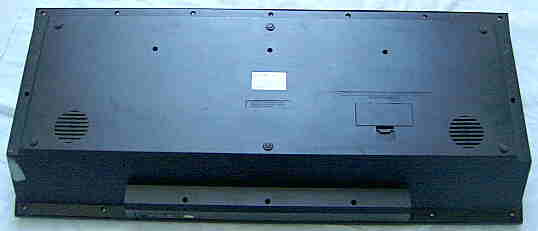 |
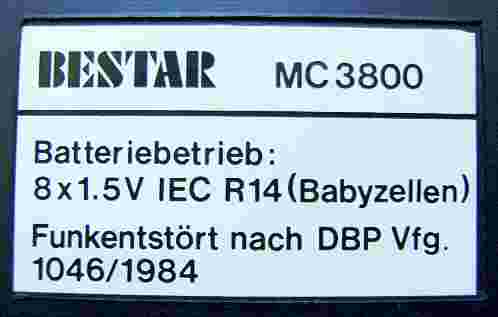 |
 |
the preset sounds {00..11} can be also selected by entering {88..99} instead.
The 87 sound bank includes beside semi- natural instrument imitations also many nice synth effects including odd wahwah stuff with rastered timbre sweeps and a lot of zipper noise (e.g. "hand bell", "fireworks"), or metallic spring noises (e.g. "leaf spring", "handsaw"). Many preset sounds resemble the Fujitone 6A (see there), but unlike the latter it has only plain 2 operator FM without sophisticated envelope tricks (i.e. no sirens or mandolin ring etc.), thus preset sounds those on the 6A use such complex tricks, are replaced here with usually very plain sounds (like organ, brass or e-piano timbre variants) although both instruments share the same sound names. Also many other sounds differ in detail from the 6A, but there are still nice synth sounds on it. Likely the sound set of the MC 3800 is genuinely based on early Yamaha FM keyboards, because e.g. the Yamaha PSS-140 also features many sounds with the same names. Also the FM sound chip sounds like an imitation of the Yamaha OPL2 (known from early Adlib PC sound cards). The vibrato of the "vibrato" button is quite fast (6Hz) but not really strong. The "sustain" button sets the sustain (release phase) to a fixed duration of 1 second, which can be shorter or longer than the default sustain duration of that sound. Great is also that (like most FM keyboards) the timbres are time- dynamically playable, i.e. the timbre of notes changes depends on how long a key is pressed, which provides a relatively expressive playability despite the keyboard is not velocity sensitive. Vibrato and sustain also affect the accompaniment. Due to its separate FM sound chip, also this instrument can be likely easily modified into a simple FM synthesizer, like I did with the Fujitone 6A. Unfortunately a polyphony flaw semi- randomly truncates held notes during fast play (similar like with the old My Music Center). The flaw appears only with accompaniment / chord mode disabled ("auto accomp" slider is "off"), thus with accompaniment the polyphony works normal. Strange is also that the flaw can be often reduced (but not fully eliminated) by switching "auto accomp" back and forward into different accompaniment modes and playing a few notes, thus it is likely a software bug.
The "stereo symphonic" effect seems to be made from an (analogue?) pitch shifter that makes the sound howl a bit (both stereo channels detuned against each other?) while it alternatingly flutters faster and slower. (It sounds like a mild dose of phaser effect.) The effect is enabled by default after power on, but can be switched on and off with its button.
The 8 drumpads play low resolution percussion samples, those sound fairly fat and a little dull. The "cymbal" may be a loop sample. After switching the instrument on, the first drumpad press always makes a popping noise in the speakers; likely a capacitor charges somewhere during this.
The percussion of the rhythms has the typical electronic FM timbre known
from the OPL3 "MIDI synth" of early PC soundcards. The tempo can be set
between fairly slow and quite (but not extremely) fast. The accompaniments
are partly a bit unusual; especially "country", "samba" and "bossanova"
contain short blipping, glitch- like staccato notes like with Ramasio
892 or Penrod AJ-430. The
OBS rhythm buttons change running rhythms immediately, and thus can be
used as a realtime sound control. With rhythm off, there is a manual single
finger chord mode which timbre also depends on the currently selected (but
not started) rhythm. (Switching rhythms stops any held accompaniment notes.)
In fingered chord mode ("auto bass chord") the accompaniment accepts
any disharmonic note combinations and not only a few establishment chord.
Beside single finger and fingered chord, there are additionally the "auto
chord" mode and "auto bass mode". In "auto chord" mode the accompaniment
keys play manual bass, while fingered standard chords are also recognized
and play automatically. In "auto bass" mode the chord is played completely
by hand in the accompaniment section, while the automatic bass recognizes
and follows any played standard chords. Especially the latter 2 modes are
good to hear the staccato notes of the accompaniments. Unfortunately there
are no independent rhythm and accompaniment volume controls, and their
common slider has only 5 steps and no "off" (mute) position.
hardware detailsThe Bestar MC 3800 is based on 2 Intel 8051 CPUs combined with FM sound IC "CW3168" (Yamaha YM2168?) and sample percussion IC "HT8852".
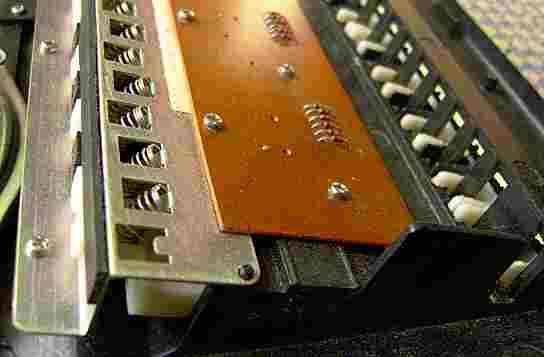 The
hardware is a quite complex and costly design and was likely one of the
first "MC" series keyboards (made by Medeli?). E.g. the keys are
made from individual plastic (duroplastic?) parts mounted on a metal rail
with individual springs, and the hardware uses Intel brand ICs,
and the main CPU IC3 (12 MHz) runs quite warm (I hope it won't toast). The
hardware is a quite complex and costly design and was likely one of the
first "MC" series keyboards (made by Medeli?). E.g. the keys are
made from individual plastic (duroplastic?) parts mounted on a metal rail
with individual springs, and the hardware uses Intel brand ICs,
and the main CPU IC3 (12 MHz) runs quite warm (I hope it won't toast).
The electronics is placed on 2 stacked PCBs with a copper coated empty
PCB on top and in between for RF shielding. Bizarre is these have a drill
hole pattern like a regular PCB (perhaps from a factory machine test). Note: Do not confuse the MC 3800 with the MC-38; although many technically identical MC keyboards exist in model name variants with either 2 digit or 4 digit MC numbers (like "MC-**" or "MC **00" where ** are the same ciphers), the MC 3800 is an exception of this rule. This may hint that it is one of the oldest MC series instruments; its PCBs are labelled with "ME-38*" (where * is a letter), thus ME-38 may be the genuine name of this hardware class. The chip software numbers with "CW65*" hint to the same manufacturer like certain other buggy trash keyboards (e.g. Bestar MC-3300, ABA-88), so they may be all made by Bestar. |
The demo melody is an improvisation that starts with a bit of "For Elise" followed by disharmonic "free jazz" stuff that cycles through many sounds and then repeats with different rhythms (definitely one of the worse keyboard demos).
A bizarre behaving midsize tablehooter with similar case style was the
Bestar
MC-3300.
| removal of these screws voids warranty... | ||
 |
||
|
|